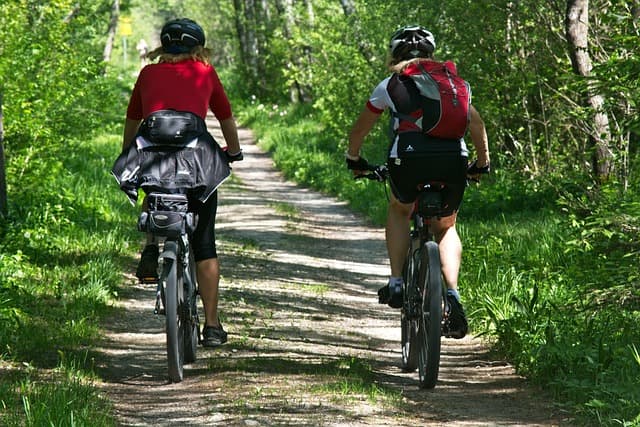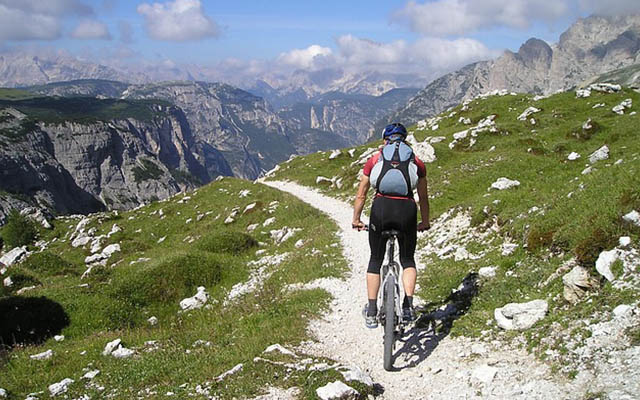Depending on the terrain and level of experience, a 100-mile bike ride could take anywhere from 4 to 10 hours. In addition, the efficiency and performance of your bike may not be directly correlated with the time required.
How long does it take to travel a hundred miles? That is the question we will explore in this article. We’ll also go over a number of things to think about before embarking on a century ride. If you want to learn more about riding 100 miles, please read it completely.
Table of Contents
What to Consider before 100 Miles Ride?
A century ride requires a significant amount of time to complete. You must make a significant effort to get everything ready if you want it to be successful. Before starting a 100-mile bike trip, take into account the following advice.
Train Yourself Systematically
Before your first 100-ride, you must prepare. To break the 100-mile barrier, you must give your body the volume and intensity of training it needs. Before beginning your journey, ride for a minimum of five hours per day at a speed of 15 mph.
If you put in a lot of effort without any prior practice, you’ll feel out of sorts. You must methodically and rationally increase your stamina. Try to keep upping your daily difficulty level by lengthening your practice sessions and raising your average speed.
Drive the 100-mile Route
To get a feel for the upcoming terrain, ride or drive the 100-mile path. If you have the chance to practice it, that is always preferable. You will be able to travel the distance more easily the more you comprehend the terrain.
It is important to take note of important elements like the gear you require and how to keep your pace. Pay close attention to these seemingly unimportant details that have a big impact on your riding experience as you practice riding on the track. Prior to embarking on a century ride, a solid plan is helpful.
Dressing is Important
Everyone has a different opinion on how to dress appropriately for the big day. In actuality, though, it is dependent on the circumstances and the weather. Because it can significantly affect your physical strength while cycling, the weather is primarily what determines how you should dress.
Some people cover themselves in warm clothing to stay warm. But even if you wear warm clothing, your body heats up as you paddle, making the experience uncomfortable. Wear a waterproof jacket on top and a sweat-wicking sleeveless jacket underneath.
Fuelling
The body requires energy to operate properly, just like a vehicle does. One of the most important things for a century ride is a proper diet, which you must ensure to maintain your energy. Additionally, digestion gets more difficult the longer you ride. As a result, adjust your diet plan.
The night before you leave on your journey, you need to start feeding your body. Feed yourself well with carbs the night before, and then in the morning, eat a slow-burning breakfast. As soon as you start cycling, it would be best to refuel yourself every 45 minutes.
Also, remember to eat something substantial before the ride and move on to something chewable and easily digestible as you go. The best foods for fueling up while riding are carb-based, such as protein bars, sandwiches, and bananas.
Proper Hydration is Important
Dehydration exacerbates hyperthermia and rising temperatures. While riding, hydrate beforehand and frequently. Bring two water bottles with you for a century ride. Drink even before you start to feel thirsty. For your information, cold liquids are simpler to drink.
However, when something positive is overdone, issues can also result. Most athletes, without specialized training, are unable to digest more than one quart of liquids per hour. A high fluid intake could result in intestinal swelling and a drop in blood salt levels.
Set Up Your Bike
If you feel comfortable, you can ride a long distance on your current bike. Instead of relying solely on the mechanics, every biker needs to check his or her own bike. Before starting a century ride, check your bike thoroughly.
Your bicycle’s fit is the first issue to address. You run the risk of straining your muscles if you attempt to pedal for an extended period of time while uncomfortable with your bike. Without the right training, you risk straining a muscle, which would be terrible for an athlete.
If you bike in bad weather or even on slick roads, you’ll get soaked. For long-distance cycling inclement weather, installing suitable, full-cover mudguards is advised. Check any additional components of your bike that might be necessary for the century ride.
Male Cycling Times
The average time required for a male rider to cover 100 miles on a bike depends on his abilities and background. The ride time varies in accordance with each course’s terrain type.
According to data from cyclinglevel.com, it takes men 6 hours, 24 minutes, and 43 seconds to complete a 100-mile race.
People of all ages can use it. Male riders with or without training, however, could cause the data to change. Male cyclists with more experience typically complete a century in 5 hours at 20 mph.

Female Cycling Times
The ride time between men and women is not particularly different. Calculating the time required to cycle 100 miles will be made easier by taking into account the female cyclist’s capabilities.
A century ride can be completed in 6 to 7 hours at a pace of 15 mph, depending on the terrain and the cyclist’s skill.
As we delve into the answer behind how many hours it would take for female bike riders to ride a century, here are some practical tips you should check out:
Before 100 Mile Ride
It takes quite a while to complete a century ride. In order to ensure a worthwhile ride, you must put a lot of effort into getting yourself and the required equipment ready.
Plan the Route You Are to Take
The best experiences involve long rides with beautiful scenery as a backdrop. Create a strategy for your long-route bicycle adventure that will allow you to pass through scenic areas.
You can find the best routes by using GPS applications. A planned route will also guarantee your safety while you are on the cycling adventure.
Fill Your Appetite
Cycling is a moderate-impact aerobic activity that uses up a lot of energy. Having a filling first meal will give you a good start because you will be pedaling for several hours.
You can stay energized while driving by bringing a packed lunch and protein bars for snacks.
Set Your Bike for Action
A suitable bike is necessary for a long ride. Checking each component will reduce the likelihood of unlikely incidents happening in this way.
Long-term performance improvement comes from adjusting the bike’s stance to your personal level of comfort.
Condition Yourself
Every preparation ultimately depends on your aptitude. Train a few days before the century ride trip to become accustomed to the terrain and longer bike rides.
As part of your training program, you can cycle 50 miles per day and gradually increase that to 70 to 75 miles on the weekends.
Before D-Day, make sure you give your body enough time to prepare.
During the 100 Mile Ride
It might be difficult to maintain your energy for the entire 100-mile ride. Given how difficult it is to bike 100 miles, making smart pedal strokes would enable you to complete the course without too much difficulty.
When you first begin to pedal, try to go slowly and then gradually speed up. Do so and take a break to refuel yourself if you feel the need to temporarily slow down or stop.
After Riding the Century
It’s important to cool down after riding, just like after any other form of exercise. It will enable your body to regain its pre-exercise vitals, avoiding muscle injuries that you don’t want to happen.
Take a 10- to 15-minute bicycle ride after reaching 110 miles before calling it a day. The meal you eat after the ride should be rich in nutrients like protein and carbohydrates to help you replenish the energy you lost during the lengthy ride.
How to Tell If You’re Ready for a Century Ride?
Clocked at Least 4:30 to 5:00 Hours in the Saddle
More than 20 years of endurance (and ultra endurance) cycling has taught me that the fifth hour into an event is the hour of reckoning, where any errors in fit, pacing, hydration, nutrition, and so forth will rear their ugly heads. A rolling century will take you 6 to 7 hours (using 15 mph as an average), unless the 100-mile race you’re targeting is pancake flat and you can easily cruise at 20+ mph (in which case you can adjust that maximum time downward). You can practice all you need to know and feel confident on event day by working up to at least one ride of at least five hours.
You Can Assume—and Hold—Your Riding Position
Any minor discomfort you experience after a few hours in the saddle will turn into a bothersome pain once you reach five hours and beyond. If you have a century in your sights, be sure to address any “little” fit issues like neck pain or back aches, knee twinges, and numb hands or feet, because they’ll only become more pronounced as the miles wear on. According to research, your upper body is crucial for both generating power as you pedal and supporting your weight while you ride. Strengthening the supporting muscles in your core, shoulders, and arms can help eliminate pain and fatigue, improving your endurance overall.
Fueling is Dialed
Nothing sidelines an otherwise successful century like bonking or a raging case of rot gut (nausea generally from too much sugar). First-time 100-mile riders frequently undereat early in the event because they are excited and don’t feel hungry, but then their energy levels suddenly sputter like a car on fumes. Same goes for taking in adequate fluids to stave off overheating and dehydration, both of which can sneak up on you after 4 or 5 hours of riding. To perfect your nutrition and hydration, practice during your training.
Prepared for Anything
My first century came close to curing me of centuries. It was the Santa Fe Century in Gainesville, Florida, which covers more than 100 miles while climbing just 1,000 feet. I live in Pennsylvania, where whether we want to or not, we climb that much every 10 to 20 miles. After 40 miles of continuous flat-pounding in the saddle, everything started to hurt.
If you plan to stay close to home, your training in the region will probably have prepared you for the terrain you’ll encounter. When going somewhere new for your century, do some research and try to simulate the terrain on your practice rides.
Comfortable in a Crowd
Most organized centuries start out as a rolling mob, and no matter where you position yourself at the start, you’re bound to find yourself pedaling in a pack or paceline of unfamiliar faces at least until the ride thins out. It will be much easier to calm your nerves and enjoy that first century if you are at ease riding with other people and are able to recognize which wheels to follow and which wheels to avoid.
FAQs
Can You Bike 100 Miles in a Day?
It sounds impossible, but you can cycle 100 miles in a day. It might be a difficult process that takes longer than usual for new bike riders, or it might be the opposite for seasoned bike riders.
Is 100 Miles on a Bike Hard?
Cycling 100 miles is a difficult but doable endeavor. Preparing beforehand will undoubtedly help you become accustomed to the bike ride because this requires a bigger time commitment and physical effort.
Everything will go smoothly on your subsequent ride if you keep your training objectives in mind.
Is Cycling 100 Miles Good for You?
You can decide if it’s worthwhile to attempt the 160km cycle by recognizing the value of the objectives you’ve set.
The number of calories burned during a century ride demonstrates the value of doing so, whether or not you did it to achieve your fitness goals.
How Long It Takes to Prepare for a 100-mile Ride?
Generally speaking, it takes several months to adequately train for a 100-mile bike ride. It depends on your current level of fitness, as well as the daily training and exercise you perform. If a physically fit rider practices for eight hours each day and rides 25 miles each time, it only takes one month.
Can a Beginner Achieve the Hundred-mile Goal?
Despite the difficulty, it is not impossibly impossible. A dedicated and enthusiastic rider in good physical condition can succeed. But it must be exhausting but enjoyable to reach this objective on your first bike ride. If the rider doesn’t have strong muscles, issues like cramps could occur.
Is a Marathon Or a 100-mile Ride Tougher?
A 100-mile ride is not as difficult as a marathon. The hundred-mile ride can be completed at a pace that is convenient for you. The other cyclists in front of and behind you must be considered in a marathon, though. Additionally, it requires more effort and practice.
Conclusion
This was all about how long does it take to bike 100 miles. You must realize that the answer to this query does not solely depend on your individual capabilities. In a nutshell, it depends on how you ride, the terrain, the wind, and your level of fitness.
Make sure you have the right fuel and make a plan before you embark on an exciting 100-mile bike ride. Enjoy your century ride and stay on course!
Read about



